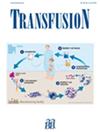Comparison of manual titrations to automated microplate and gel titration assays used in the screening of blood donors for production of Low-Titer O Whole Blood.
IF 2.5
3区 医学
Q2 HEMATOLOGY
引用次数: 0
Abstract
BACKGROUND The popularity of Low-Titer O Whole Blood (LTOWB) for treating trauma patients requires that donor centers and transfusion services make decisions on what titer testing capabilities to institute and an appropriate titer level threshold. This study compared the titer results determined by four methods to find a rate of agreement. STUDY DESIGN AND METHODS Isohemagglutinin titers were tested on 300 plasma samples utilizing various methods, each determining IgM antibody levels by direct hemagglutination with A1 and B reference cells. The methods used were the Beckman Coulter's PK7300, Immucor's NEO Iris microplate technology, Ortho Clinical Diagnostics (OCD) Vision, and manual titrations. RESULTS Only 42.7% of the samples tested showed agreement across all methods on ABO isohemaglutinin titer levels and only 32.5% demonstrated "High titer" agreement. Sample agreement was close to 90% if the Immucor method was excluded. At a <1:256 titer level threshold, the pass rate was 94.3% for Immucor, 89.7% for the PK7300, 87.3% for manual testing, and 75.7% for OCD's gel method. Sensitivity and specificity rates at a ± 1 titer level were respectively 100% and 95.4% for OCD's gel, 73.7% and 100% for Immucor, and 100% and 99.6% for the PK7300. Overall method accuracy was 91.7% for Immucor, 90.3% for the PK7300, and 86.7% for OCD's gel method as compared to manual titration. CONCLUSION All three automated methods perform comparably to the manual method at a ± 1 titer tolerance level. Based on these comparisons, a titer level of <1:256 would maximize LTOWB production regardless of the method used.人工滴定与自动微孔板和凝胶滴定测定在筛选献血者生产低滴度 O 型全血中使用的比较。
背景低滴度 O 型全血(LTOWB)用于治疗创伤患者的普及要求捐献中心和输血服务机构决定采用何种滴度检测能力以及适当的滴度水平阈值。本研究比较了四种方法确定的滴度结果,以找出一致率。研究设计与方法对 300 份血浆样本进行了血凝素滴度检测,每种方法都采用不同的方法,通过与 A1 和 B 参考细胞直接血凝来确定 IgM 抗体水平。结果只有 42.7% 的受测样本显示所有方法的 ABO 异血凝素滴度水平一致,只有 32.5% 的样本显示 "高滴度 "一致。如果排除 Immucor 方法,样本的一致性接近 90%。在滴度水平阈值小于 1:256 时,Immucor 的通过率为 94.3%,PK7300 为 89.7%,人工检测为 87.3%,OCD 的凝胶法为 75.7%。在±1滴度水平上,OCD凝胶法的灵敏度和特异性分别为100%和95.4%,Immucor为73.7%和100%,PK7300为100%和99.6%。与手动滴定相比,Immucor、PK7300 和 OCD 凝胶法的总体方法准确率分别为 91.7%、90.3% 和 86.7%。根据这些比较,无论使用哪种方法,滴度水平<1:256都能最大限度地提高LTOWB产量。
本文章由计算机程序翻译,如有差异,请以英文原文为准。
求助全文
约1分钟内获得全文
求助全文
来源期刊

Transfusion
医学-血液学
CiteScore
4.70
自引率
20.70%
发文量
426
审稿时长
1 months
期刊介绍:
TRANSFUSION is the foremost publication in the world for new information regarding transfusion medicine. Written by and for members of AABB and other health-care workers, TRANSFUSION reports on the latest technical advances, discusses opposing viewpoints regarding controversial issues, and presents key conference proceedings. In addition to blood banking and transfusion medicine topics, TRANSFUSION presents submissions concerning patient blood management, tissue transplantation and hematopoietic, cellular, and gene therapies.
 求助内容:
求助内容: 应助结果提醒方式:
应助结果提醒方式:


